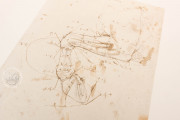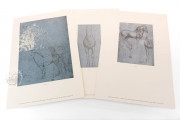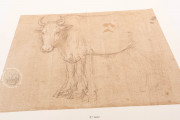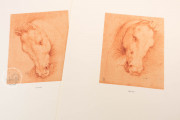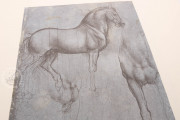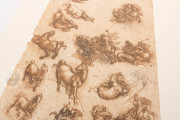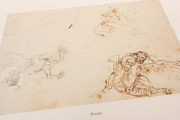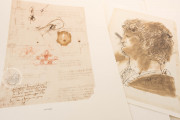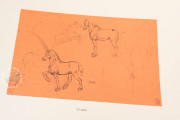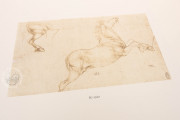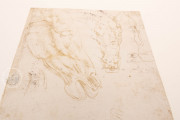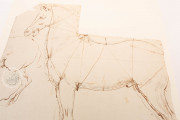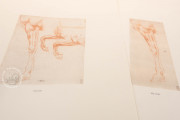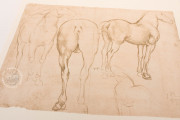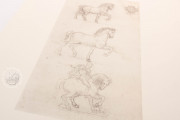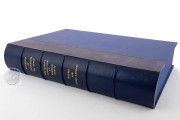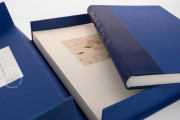The collection Drawings of Horses and Other Animals by Leonardo da Vinci includes the reproduction of a selection of ninety-one drawings whose originals are treasured at the Royal Library at Windsor Castle, offering a vivid illustration of the artist’s intrigue with the animal kingdom. These sketches not only highlight Leonardo's exceptional artistic skill but also shine a light on his acute powers of observation and deep comprehension of animal anatomy and kinetics.
The equine subjects are rendered with distinctive care and personality, standing out against the other animals in the collection—dogs, cats, oxen, and even mythological beasts like dragons. It is in his depictions of horses, indeed, where Leonardo's empathetic eye and precision in detailing are most evidently applied, underlining the prominence of these creatures in his body of work.
The collection includes the following groups of drawings:
XI. Horse and Dragon Studies for Early Adorations, ca. 1478-80
XII. Proportion Studies, ca. 1480-93
XIII. Studies for the Sforza Horse, ca. 1483-95
XIV. Studies for Anghiari Horses, ca. 1503-5
XV. Studies for the Trivulzio Horse, ca. 1508-13
XVI. Horses and Other Animals in Late Allegories, after 151
(The groups of drawings from I to X are featured in vol. I Landscapes and Plants and Water Studies).
From Verrocchio's Workshop to Windsor: Leonardo's Equestrian Art
During his apprenticeship in Verrocchio's studio in the 1470s, Leonardo da Vinci recognized the importance of establishing a canon of proportions for horses, mirroring the human studies by Alberti. This was part of a renaissance of classical beauty ideals. Leonardo studied ancient horse statues and also created a measuring device for his proportion studies, which were integral to his creation of the Book on the Horse, unfortunately said to be lost during the 1499 French invasion of Milan.
Nonetheless, Leonardo's surviving horse studies were later compiled into a large volume, which entered Charles I of England's collection around 1630 after being purchased by Lord Arundel in Spain. For over two hundred years, this collection was seen by very few until a selection was exhibited in London in 1878. The collection became widely known to scholars following this exhibition, but it was only in 1935 that Kenneth Clark published his definitive catalog of the entire Leonardo collection at Windsor Castle.
Subgroups within this Collection:
This selection of drawings, through its various subgroups, offers a comprehensive view of Leonardo da Vinci's enduring fascination with horses and his mastery in capturing their form and spirit. The attention to detail, the exploration of movement and anatomy, and the integration of horses into larger thematic works all underscore Leonardo's genius as an artist and a keen observer of the natural world.
The bulk of the collection focuses on some of Leonardo da Vinci's key projects, which marked his career from his early years with the Adoration of the Magi, through his peak period with the Sforza Monument, to his later endeavors like the Battle of Anghiari and the Trivulzio Monument. His horse drawings for these works, reflective of his meticulous observation and understanding of proportion, escape monotony through his vivid depiction of the animals' vitality.
Early Adoration Studies: These initial drawings, focused on the Adoration theme, mark the beginning of Leonardo's detailed exploration of horse anatomy and movement.
Proportion Studies: In these works, Leonardo meticulously studied horse proportions, aiming to establish a canon of equine beauty. These studies reflect his efforts to blend observation with classical ideals of beauty.
Sforza Horse Studies: The studies for the colossal horse of the Sforza Monument occupied Leonardo for about fifteen years, but the sculpture was ultimately unrealized due to the requisition of the bronze for military use. In the sketches pertaining to this group, Leonardo's evolving style is evident from the initial concept of a rearing horse to later plans showing the horse alone in motion, suggesting a rider in triumphant attire. Changes in the project could reflect shifts in Leonardo's own vision or the patron's political goals. Despite its non-completion, Leonardo's effort on the colossal statue set a precedent for scale and ambition in sculpture.
Anghiari Horses Studies: These works were part of Leonardo's preparation for the Battle of Anghiari mural, a planned painting by Leonardo da Vinci in the Salone dei Cinquecento in the Palazzo Vecchio, Florence. Leonardo's preparatory drawings capture the dynamism and energy of horses in battle, highlighting his mastery in depicting movement and showcasing a blend of dynamism, anatomy, and expressive energy that foreshadows the Baroque grandeur.
Trivulzio Horse Studies: The later part of Leonardo's career is reflected in these studies, which were for another equestrian monument. They show his continued interest in horse anatomy and proportions.
Horses in Late Allegories: In his later years, Leonardo's horse drawings became part of larger allegorical works, blending his interest in horses with broader themes.
We have 1 facsimile edition of the manuscript "Drawings of Horses and Other Animals by Leonardo da Vinci (Collection)": Drawings and Miscellaneous Papers of Leonardo da Vinci in the Collection of Her Majesty the Queen at Windsor Castle: Horses and Other Animals facsimile edition, published by Johnson Reprint, 1987
Request Info / Price


